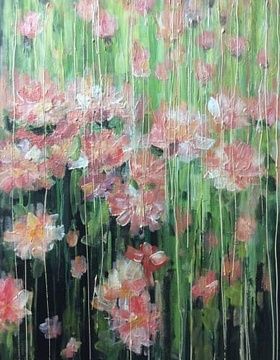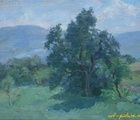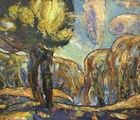
Пейзаж - один из жанров живописи
Во французском языке это слово имеет значение «местность, страна», и его темой является как раз определённая местность.
Привычнее всего под понятием «пейзаж» подразумевать только изображение природы, но оно шире: пейзаж может быть архитектурным, городским.
А документально точное изображение в городском пейзаже называется «ведутой» (итал. veduta). Излюбленным жанром голландских (нидерландских) художников был не только натюрморт, но и ведута.
Развитие пейзажного жанра
Пейзажный жанр формировался постепенно, в соответствии с наукой. Оказывается, между пейзажной живописью и наукой много общего, т.к. при создании реалистического пейзажа необходимо иметь понятия о воздушной перспективе, пропорциональности, светотени и т.д.
Такой привычный и знакомый для каждого жанр пейзажа долгое время был только подсобным, как фон, хотя был известен ещё в древневосточном изобразительном искусстве. Природу изображали в качестве фона на портретах, иконах. В таком варианте он чаще был идеализированным, обобщённым.
Поэтому пейзаж считается относительно молодым жанром живописи - самостоятельное значение он получил примерно в XIV в.
Разновидности пейзажа
В жанре природного пейзажа выделяют морской и космический пейзажи. Марина (от лат. marinus - морской). Художники-маринисты изображали морской вид, сцены морских сражений и всё, что было связано с морем. Российский художник Айвазовский написал около 6 тысяч морских пейзажей (марин).
Космический пейзаж - изображение небесного пространства, планет и звезд.
С точки зрения времени пейзаж может быть историческим, футуристическим (пейзаж будущего), современным.
Пейзажи различаются по принадлежности к определённому стилю искусства
Например, романтический пейзаж английского художника Уильяма Тёрнера необыкновенно поэтичен, прозрачен. Пейзажи немецкого художника Каспара Давида Фридриха отличаются мистической атмосферой, а реалистичные пейзажи Ивана Шишкина изображают величественную красоту северных просторов, причём в основе многих картин художника лежит «портретное» изображение конкретного места.
Европейский пейзаж
В европейской живописи явный интерес к пейзажу проявился в эпоху Раннего Возрождения. Итальянский художник Джотто в XIII в. изображал пейзаж в трёхмерном пространстве, создавая иллюзию глубины. Но в его время пейзаж всё-таки оставался вспомогательным средством.
В эпоху Высокого Возрождения (XVI в.) пейзажная живопись уже начала интенсивно развиваться, особенно в творчестве художников Венецианской школы Джорджоне, Тициана, Эль Греко.
Свобода и искренность отличает пейзажи нидерландского художника Питера Брейгеля (Старшего).
Испанский художник Веласкес делал первые попытки пленэрной живописи (на открытом воздухе), хотя её основоположником считается английский художник XIX в. Джон Констебль. Большой вклад в развитие пленэрной живописи сделали французские художники-импрессионисты (Коро, Писсарро, Ренуар, Моне), которые стремились передать на своих пейзажных полотнах движение воздуха.
Пейзажи Рубенса были такими же жизнеутверждающими и динамичными, как и его персонажи.
Русский пейзаж
В России пейзажная живопись всегда пользовалась популярностью и интенсивно развивалась. Многие картины русских художников считаются шедеврами пейзажной живописи. Самостоятельным пейзажный жанр в России стал в XVIII в. Основоположником его считается Семён Щедрин (1745-1804). Его пейзажи эмоциональны, выразительны и наполнены светом.
Ф. Алексеев (1753/1755-1824) одним из первых начал писать городские пейзажи, он крупнейший мастер русской ведуты.
А. Мартынов (1768-1826) много путешествовал по России и создал пейзажи Сибири, Крыма, берегов Волги.
Сильвестр Щедрин (1791-1830) - автор замечательных романтических пейзажей.
А. Венецианов (1780-1847) был автором неярких пейзажей среднерусской полосы.
Вторая половина XIX в. дала целую плеяду талантливых пейзажистов: Ф. Васильева, В. Борисова-Мусатова, Б. Кустодиева, А. Саврасова, А. Куинджи, И. Шишкина и др. Все пейзажные традиции продолжили своё развитие и в XX в. в творчестве П. Кончаловского, И. Грабаря, К. Юона и многих других художников.
Популярен пейзаж и в наше время, это вечный жанр, и он никогда не иссякнет.
Из истории пейзажа
Хотя некоторые считают, что именно Леонардо да Винчи был автором пейзажной живописи, это распространенное заблуждение. Историю пейзажа можно проследить до Китая 4 века н.э., когда китайские художники стремились перенести на картины свои впечатления от окружавшей их природы. Фактически, этот жанр стал настолько популярным, что начало 9-го века называют рассветом китайского пейзажа.
В западной традиции не всегда было принято ценить природу как таковую. Ландшафты обычно использовались в качестве фона для исторических картин или портретов. Пейзаж в Европе стал популярным жанром только в 17 веке. Есть некоторые свидетельства пейзажной традиции Древней Греции и Рима, но на этих картинах часто присутствовали и другие значимые элементы, кроме ландшафтов. «Пешеходный мост» Альбрехта Альтдорфера, датируемой началом 16 века, считается первым настоящим пейзажем в истории западного искусства.
В эпоху Возрождения пейзажная живопись стала серьезным художественным жанром. Из Италии она пришла в остальные страны Европы, и с французскими художниками Клодом Лорреном и Николя Пуссеном стала доминировать. Ранние европейские пейзажи представляли собой сильно стилизованные произведения, имитирующие пейзажи Древней Греции и Рима - в основном, это были идеализированные пасторальные сцены. Между тем, известные голландские художники в 17 веке начали развивать более натуралистический стиль, что можно увидеть в работе Арта ван дер Неера «Лунный пейзаж с мостом».
Французская академия классифицировала жанры искусства, поставив пейзаж на четвертое из пятых в порядке значимости. Этот рейтинг продемонстрировал довольно пренебрежительное отношение общества к природе в то время. Однако в 18 веке жанр пейзажной живописи по-настоящему воплотился в жизнь. Бум его популярности был результатом двух факторов: появления идеи о том, что природа является прямым проявлением Бога на земле, и безудержной индустриализации и урбанизации большей части Западной Европы во время промышленной революции. Промышленность отделила людей от природы, породив пронизанное ностальгией желание прославить окружающий мир во всей его красе. Пейзажная живопись была описана Джоном Раскином как «главное художественное творение девятнадцатого века». Нигде эта традиция не была более популярной, чем в Великобритании, где промышленная революция нашла свой эпицентр. Здесь пейзажную живопись воплощали два мастера жанра: Джон Констебл и Джозеф Мэллорд Уильям Тернер.
Между тем, во Франции импрессионисты продолжили эту тенденцию и добавили в жанр своего собственного чутья. Такие художники, как Клод Моне и Пьер Огюст Ренуар, использовали сознательно неформальный подход, стирая границы между эскизами и готовыми произведениями. Они делали набросок сцены напрямую - на пленэре - и отказались от традиционных техник, таких как светотень и перспектива, чтобы напрямую воплотить свой собственный опыт. Вскоре как в Великобритании, так и во Франции традиционная иерархия жанров рухнула, и пейзаж стал одной из самых популярных форм живописи.
В начале 20 века «Школа реки Гудзон» положило начало развитию самобытной пейзажной живописи в США. Именно в США жанр был расширен за счет включения промышленных и городских пейзажей.
Из выдающихся, прославившихся на весь мир русских пейзажистов следует упомянуть Исаака Левитана, Ивана Шишкина, Ивана Айвазовского.


























